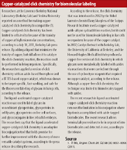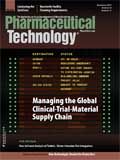Catalyzing the Synthesis
Researchers develop various catalytic approaches for improving yield, purity, stereoselectivity, and process conditions.
Catalysts play an important role in chemical reactions, but they are particularly important in producing fine chemicals or pharmaceutical compounds to meet desired yields, purity, and stereoselectivity. Elucidating how a catalyst may work in a specific synthesis is not only valuable for a given project, but it contributes to an overall understanding of process chemistry. Some recent advances involve asymmetric synthesis and approaches for improved enantioselectivity, oxidation catalysis, and the development of boron-based ligands.

IMage: Jason Reed / GETTY
Improving enantioselectivity
Researchers at the University of Amsterdam recently reported on an approach for identifying and developing catalysts to synthesize products with high enantioselectivity, a method of utility for making pharmaceutical compounds. The researchers reported on the development of an achiral bisphosphine rhodium complex, which contained a binding site for recognizing chiral anion "guests" or cofactors. Upon binding the small-molecule cofactors, the rhodium complex becomes chiral and can then be used in asymmetric catalysis. The researchers screened a library of cofactors and discovered the optimal cofactors, which led to the identification and development of hydrogenation catalysts that formed products with enantiomeric excess as high as 99%. The researchers also conducted a competition experiment to determine the optimal cofactor among a mixture of 12 cofactors. The optimal cofactor was one that binds strongest to the rhodium complex (i.e., the catalyst) and through the catalyst produced the product with greatest optical purity. The competition experiment provided the basis for creating an efficient way to screen a library of cofactors with other metal–ligand systems (1, 2). The University of Amsterdam chemists have patented the strategy and plan to develop it alongside their other high-throughput ligand-screening strategies through a spin-off company, InCatT.

Patricia Van Arnum
Raising the bar in catalytic hydrogenation
Researchers at the University of Alberta recently developed a new ruthenium-aminophosphine catalyst with very high turnover. The catalyst system was used for the hydrogenation of a variety of acyclic and cyclic amides to the corresponding alcohols and amines. They reported catalytic activity with turnover as high as 7200. Specifically, the researchers reported that the reaction between 2 equivalents of Ph2P(CH2)2NH2 and cis-[Ru(CH3CN)2 (η3-C3H5) (cod)]BF4 (cod = 1,5-cyclooctadiene) formed a highly active catalyst precursor for the selective hydrogenation of amides. The reaction proceeded with good atom economy, yield, and turnover under moderate reaction conditions (3). The researchers are working to further optimize the catalyst system, according to a Sept. 28, 2011, University of Alberta press release.

Formulation development forum: translational pharmaceutics (FIGURE 1 IS COURTESY OF THE AUTHOR)
Evaluating steric and electronic effects in asymmetric catalysis
In designing a catalyst system, understanding the steric and electronic effects is important, but it is particularly important in asymmetric synthesis. Researchers at the University of Utah recently reported on a systematic approach to optimize the steric and electronic factors in designing a catalyst for the selective addition of alkyne derivatives to ketones (4). The researchers applied a three-dimensional free-energy relationship that correlated steric and electronic effects to design and optimize a class of ligands (i.e., quinoline proline ligands) for the enantioselective Nozaki–Hiyama–Kishi propargylation of ketones. The data from the study suggested that steric–electronic correlations provided an efficient optimization of a catalytic system and a synergistic relationship between steric and electronic effects in reactions. The researchers assert that the approach is particularly useful for optimizing reactions with limited detailed mechanistic and structural understanding.

Copper-catalyzed click chemistry for biomolecular labeling
Revealing the catalytic site in oxidation catalysis
Oxidation catalysis plays an important role in the chemical, fine-chemical, and pharmaceutical industries. Approximately 80% of all compounds in the chemical and pharmaceutical industries require at least one catalytic step in their synthesis, according to some estimates. Hydrocarbon compounds used to make commodity or fine chemicals often require an oxidation step, which is mediated by a transition metal compound (5). Advances in oxidation catalysis, therefore, are of broad interest to process chemists.
Researchers at the University of Virginia recently provided a study that details a new type of catalytic site where oxidation catalysis occurs. Using a titanium dioxide substrate holding nanometer-size gold particles, the researchers identified a site that serves as the catalyst at the perimeter of the gold and titanium dioxide substrate, according to an Aug. 4, 2011, University of Virginia press release describing the research.
"This site is special because it involves the bonding of the oxygen molecule to a gold atom and to an adjacent titanium atom in the support," said John Yates, professor of chemistry at the University of Virginia and co-author of a recent research article on the study (6). "Neither the gold nor the titanium dioxide exhibits this catalytic activity when studied alone," he said.
Using spectroscopic measurements, and computational-chemistry aproaches, the researchers were able to follow the specific molecular transformations and determine where they occurred on the catalyst. The researchers observed that significant catalytic activity occurred on unique sites formed at the perimeter region between the gold particles and their titania support, according to the release.
Classifying it as a dual catalytic site because two dissimilar atoms were involved, the researchers observed that an oxygen molecule bound chemically to both a gold atom at the edge of the gold cluster and a nearby titanium atom on the titania support and reacted with an adsorbed carbon monoxide molecule to form carbon dioxide. They used spectroscopy to follow the consumption of carbon monoxide at the dual site. "This particular site is specific for causing the activation of the oxygen molecule to produce an oxidation reaction on the surface of the catalyst," said Yates in the university press release. "It's a new class of reactive site not identified before."
Moreover, the study has broader implications for catalysis research. "We have both experimental tools, such as spectrometers, and theoretical tools, such as computational chemistry, which now allow us to study catalysis at the atomic level," said Yates. "We can focus in and find that sweet spot more efficiently than ever. What we've found with this discovery could be broadly useful for designing catalysts for all catalytic reactions.
Making acids behave like bases
A research team lead by Guy Bertrand, a distinguished professor of chemistry at the University of California at Riverside, recently reported on the use of boron-based compounds to build Lewis bases.
The researchers reported on the synthesis and characterization of a neutral tricoordinate organoboron isoelectronic with amines. The neutral tricoordinate boron derivative acted as a Lewis base and underwent one-electron oxidation into the corresponding radical cation. These compounds were the parent borylene and borinylium, respectively, stabilized by two cyclic (alkyl)(amino) carbenes. Ab initio calculations showed that the highest occupied molecular orbital of the borane and the singly occupied molecular orbital of the radical cation were essentially a pair and a single electron, respectively, in the p(p) orbital of boron (7).
"The result is totally counterintuitive," said Bertrand, in an July 28, 2011, University of California at Riverside press release. "...But we have achieved it. We have transformed boron compounds into nitrogen-like compounds. In other words, we have made acids behave like bases."
Nitrogen- or phosphorus-based compounds are commonly used as ligands in catalysts. "The trouble with using phosphorus-based catalysts is that phosphorus is toxic and it can contaminate the end products," Bertrand said. "Our work shows that it is now possible to replace phosphorus ligands in catalysts with boron ligands. And boron is not toxic," he added. Researchers at Philipps–Universitat in Marburg, Germany, also contributed to the study.
References
1. J.N.H. Reek et. al., J. Am. Chem. Soc., online DOI: 10.1021/ja208589, Sept. 30, 2011.
2. S. Ritter, Chem. & Eng. News89 (42), 13 (2011).
3. J.M. John and S.H. Bergens, Angew. Chem. Int. Ed. 50 (44), 10377–10380 (2011).
4. K.C. Harper and M.S. Singer, Science 333 (6051), 1875–1878 (2011).
5. F. Meyer nd C. Limber, eds., "Preface" in Organometallic Oxidation Catalysis (Springer, New York, 2007).
6. J.T. Yates, Jr., et al., Science 333 (6043), 736–739 (2011).
7. G. Bertrand, Science 333 (6042), 610–613 (2011).

Pharmaceutical Tariffs Are Imminent: How Industry is Bracing for Impact
April 16th 2025On April 14, 2025, the Trump Administration launched a national security-driven investigation into pharmaceuticals, a move that will likely result in tariffs being placed on pharmaceutical drugs, ingredients, and other components that are imported from outside of the United States.
Drug Solutions Podcast: A Closer Look at mRNA in Oncology and Vaccines
April 30th 2024In this episode fo the Drug Solutions Podcast, etherna’s vice-president of Technology and Innovation, Stefaan De Koker, discusses the merits and challenges of using mRNA as the foundation for therapeutics in oncology as well as for vaccines.